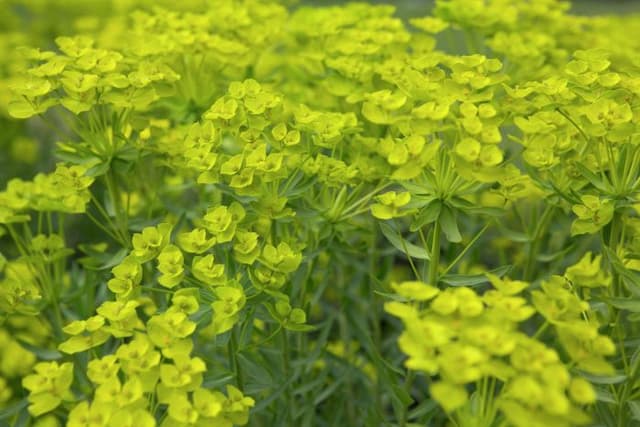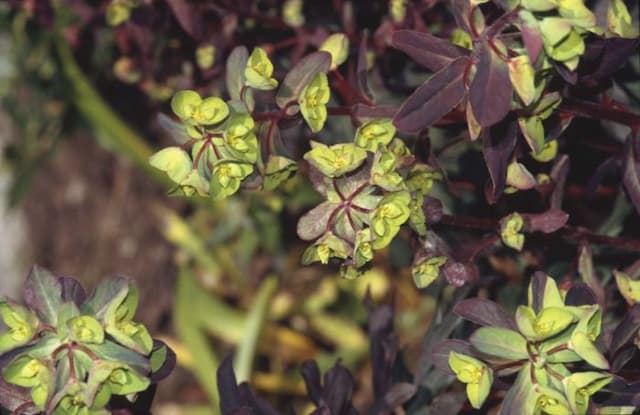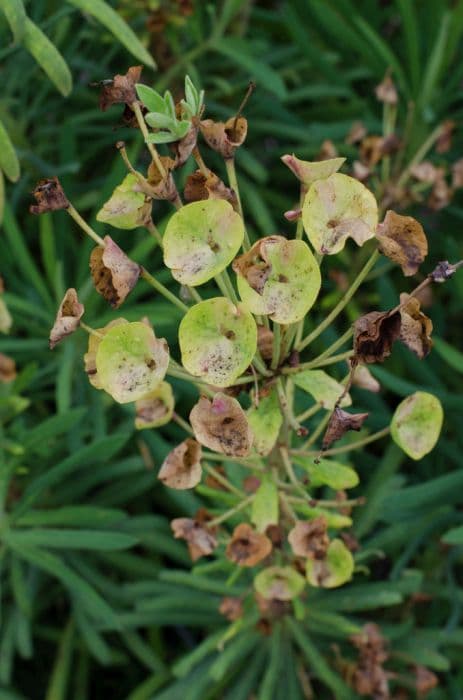Martin's Spurge Euphorbia × martini

ABOUT
Martins Spurge, as it is commonly referred to, boasts a striking appearance characterized by its dense and bushy growth. This elegant plant features evergreen foliage which grows in a rosette-like fashion, providing year-round interest. The leaves of Martins Spurge are often narrow and oblong with a smooth edge, presenting a lush green color that may exhibit hints of blue or gray, adding to its visual intrigue. During the flowering period, typically observed in late spring or early summer, the plant displays unique floral structures. Unlike typical flowers, Martins Spurge has modified leaves called bracts that surround the actual flowers. These bracts are often bright or lime green, though some may carry a yellow or reddish tint, providing a delightful contrast to the green foliage. The flower heads are small, grouped in clusters, and may seem inconspicuous when compared to the bold bracts that draw the eye with their coloration. Among the exquisite features of Martins Spurge is the presence of a milky sap within its stems. This sap, however, must be handled with caution as it can cause irritation to the skin and should not come into contact with the eyes or mouth. This adaptability of Martins Spurge, along with its decorative appearance, makes it a popular choice for adding a touch of evergreen structure to garden designs.
About this plant
 Names
NamesFamily
Euphorbiaceae
Synonyms
Martin's Spurge
Common names
Euphorbia × martini
 Toxicity
ToxicityTo humans
Martin's spurge (Euphorbia × martini) is a plant known for its toxic latex sap, which is present in all parts of the plant. This sap can cause significant irritation to skin and mucous membranes upon contact. If ingested, the sap can lead to severe inflammation of the mouth, throat, and gastrointestinal tract. Symptoms of poisoning may include pain and swelling in the mouth, vomiting, diarrhea, and in severe cases, difficulty breathing. The toxic effects can be serious, and medical attention should be sought immediately if ingestion or significant exposure occurs.
To pets
Martin's spurge (Euphorbia × martini) is also toxic to pets due to its irritating latex sap, found throughout the plant. If pets come into contact with or ingest any part of the plant, they may experience symptoms such as drooling, vomiting, diarrhea, or pawing at the mouth due to irritation. In severe cases, ingestion can cause systemic effects including weakness, seizures, or difficulty breathing. If you suspect your pet has ingested Martin's spurge, seek veterinary care immediately.
 Characteristics
CharacteristicsLife cycle
Perennials
Foliage type
Evergreen
Color of leaves
Green
Flower color
Yellow
Height
1-2 feet (0.30-0.61 meters)
Spread
1-2 feet (0.30-0.61 meters)
Plant type
Shrub
Hardiness zones
7
Native area
Mediterranean
Benefits
 General Benefits
General Benefits- Easy to Grow: Martin's spurge is low-maintenance and can thrive with minimal care, making it ideal for beginner gardeners.
- Drought Tolerant: Once established, it is quite drought-resistant, which is perfect for water-wise landscapes.
- Attractive Foliage: The plant has unique and attractive foliage that adds texture and color to garden spaces.
- Long Blooming: It produces long-lasting flowers that add visual interest to gardens throughout the blooming season.
- Deer Resistant: Martin's spurge is not favored by deer, reducing the risk of damage in gardens where deer browsing is a problem.
- Pest Resilience: It exhibits resistance to many common garden pests, reducing the need for chemical pesticides.
- Versatility in Landscaping: Suitable for mixed borders, rock gardens, and ground cover, providing flexibility in garden design.
- Seasonal Interest: It offers visual interest across multiple seasons with its evergreen foliage and seasonal blooms.
 Medical Properties
Medical PropertiesThis plant is not used for medical purposes.
 Air-purifying Qualities
Air-purifying QualitiesThis plant is not specifically known for air purifying qualities.
 Other Uses
Other Uses- Euphorbia × martini, also known as Martin's spurge, can be used in container gardening to add a unique texture and color contrast with its evergreen foliage and distinctive flowers.
- Its sap can be utilized as a natural adhesive or latex, but care must be taken due to its potential skin irritant properties.
- The plant's structural form can be incorporated into garden design principles, like xeriscaping, to create water-efficient landscapes.
- Martin's spurge can serve as a living fence or border when planted in a continuous row due to its bushy growth habit.
- Dried stems and flowers of Euphorbia × martini can be used in floral arrangements and crafts for their unique appearance and longevity.
- The plant can be utilized in ecological garden designs to encourage biodiversity by attracting beneficial insects such as pollinators.
- Its contrasting foliar color and texture can serve as a backdrop in photography, offering a natural green canvas for portraits and macro photography.
- Martin's spurge could theoretically be used in dye-making for creating natural dyes, provided appropriate extraction methods are implemented to handle the sap safely.
- When used in mass plantings, Euphorbia × martini can contribute to soil stabilization on slopes or banks with its root system.
- As a creative art medium, the distinctive shape and color of Euphorbia × martini can inspire botanical illustrations and plant-based artwork.
Interesting Facts
 Feng Shui
Feng ShuiThe Martin's Spurge is not used in Feng Shui practice.
 Zodiac Sign Compitability
Zodiac Sign CompitabilityThe Martin's Spurge is not used in astrology practice.
 Plant Symbolism
Plant Symbolism- Resilience: Euphorbia × martini, commonly known as Martin's Spurge, often symbolizes resilience due to its tough and hardy nature, capable of thriving in challenging environments.
- Protection: The plant's sap is toxic and can cause irritation, which has led to its association with protection, as it naturally defends itself against herbivores and pests.
- Adaptability: Martin's Spurge is adaptable to various conditions, symbolizing the ability to adjust and succeed in different circumstances in life.
 Water
WaterThe Martin's Spurge should be watered sparingly, as it is drought tolerant and prefers to be kept on the drier side. It's ideal to water this plant when the top inch of soil feels dry to the touch. Usually, this would translate to watering approximately every 7 to 10 days, depending on environmental conditions, but less frequent watering may be necessary during the dormant winter months. When you do water, add water slowly until it begins to drain through the holes in the bottom of the pot, indicating the soil is sufficiently moist. It might require around 8 to 16 ounces of water for a medium-sized pot during each watering session.
 Light
LightMartin's Spurge thrives best in full sun to partial shade conditions. For optimal growth, place it in a spot where it will receive at least 6 hours of direct sunlight daily. If grown indoors, a south-facing window can provide the bright conditions the Martin's Spurge needs while protecting it from the harsh midday sun that could potentially scorch its leaves in the peak of summer.
 Temperature
TemperatureMartin's Spurge is hardy and can withstand a temperature range from a minimum of around 30°F to a maximum of around 85°F, though it thrives best in temperatures between 60°F and 75°F. It’s important to protect it from frost, which can damage the plant, and equally to avoid excessively hot temperatures which can stress the plant.
 Pruning
PruningPruning Martin's Spurge is necessary to maintain its shape and to remove any dead or yellowing leaves. Light pruning can be done at any time of the year, but the best time for a more thorough pruning is in the early spring before new growth begins. Cut back the plant by up to one-third of its size to encourage a bushier growth habit and keep it looking neat.
 Cleaning
CleaningAs needed
 Soil
SoilMartin's Spurge thrives in well-draining soil with a mix of potting soil, coarse sand, and peat with a pH ranging from 6.0 to 7.5.
 Repotting
RepottingMartin's Spurge should be repotted every two to three years to refresh soil and prevent root crowding.
 Humidity & Misting
Humidity & MistingMartin's Spurge is tolerant of a wide range of humidity levels but prefers moderate conditions without excessive moisture.
 Suitable locations
Suitable locationsIndoor
Place Martin's Spurge near a sunny window and avoid overwatering.
Outdoor
Grow Martin's Spurge in full sun to partial shade and well-draining soil.
Hardiness zone
6-9 USDA
 Life cycle
Life cycleEuphorbia × martini, commonly known as Martin's spurge, begins its life as a seed, germinating in warm conditions with well-drained soil. Upon sprouting, the seedling starts to develop its distinctive foliage, forming a rosette of leaves. As the plant matures, it undergoes vegetative growth, producing sturdy stems and more leaves, and developing a deep root system. Following vegetative growth, Martin's spurge reaches the flowering stage, typically in the spring, where it displays clusters of small green flowers encased in showy bracts that can vary in color. After pollination, these flowers produce seeds, which are then dispersed to begin a new cycle. During its life, Martin's spurge may also propagate asexually through cuttings, which can root and grow into new plants.
 Propogation
PropogationPropogation time
Spring-Early Summer
The most popular method of propagation for the Euphorbia × martini, commonly known as Martin's spurge, is by taking cuttings. This is typically done in late spring to early summer when the plant's growth is vigorous. The process involves carefully selecting healthy, non-flowering stems and cutting them into sections, each about 3 to 4 inches (approximately 7.5 to 10 centimeters) long. It is important to allow the cut ends to dry and callus over for a few days to prevent rot. Once callused, the cuttings can be planted in a well-draining soil mix and kept moist until they root, which usually takes a few weeks. Extra care should be taken when handling as the sap can be an irritant.









